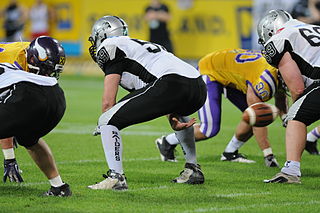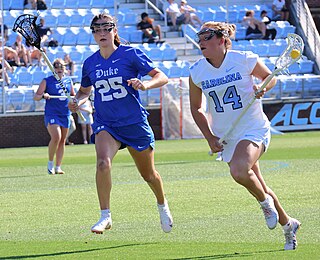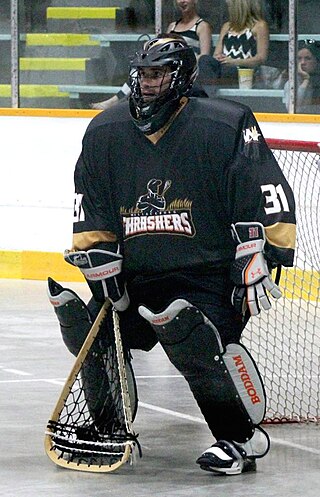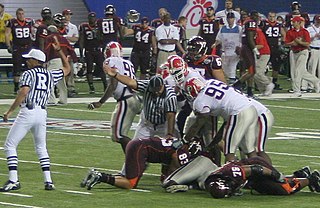
A snap is the backward passing of the ball in gridiron football at the start of play from scrimmage.

Lacrosse is a contact team sport played with a lacrosse stick and a lacrosse ball. It is the oldest organized sport in North America, with its origins with the indigenous people of North America as early as the 12th century. The game was extensively modified by European colonists, reducing the violence, to create its current collegiate and professional form.

In many team sports that involve scoring goals, the goalkeeper is a designated player charged with directly preventing the opposing team from scoring by blocking or intercepting opposing shots on goal. Such positions exist in bandy, rink bandy, camogie, association football, Gaelic football, international rules football, floorball, handball, hurling, field hockey, ice hockey, roller hockey, lacrosse, ringette, rinkball, water polo, and shinty, as well as in other sports.

In many team sports, defense or defence is the action of preventing an opponent from scoring. The term may also refer to the tactics involved in defense, or a sub-team whose primary responsibility is defense. Similarly, a defense player or defender is a player who is generally charged with preventing the other team's forwards from being able to bear down directly on their own team's goalkeeper or goaltender. Such positions exist in association football, ice hockey, water polo and many other sports.

A face-off is the method used to begin and restart play after goals in some sports using sticks, primarily ice hockey, bandy, floorball, broomball, rinkball, and lacrosse.

Women's lacrosse, sometimes shortened to lax, is a field sport played at the international level with two opposing teams of ten players each. Originally played by indigenous peoples of the Americas, the modern women's game was introduced in 1890 at the St Leonard's School in St Andrews, Scotland. The rules of women's lacrosse differ significantly from men's field lacrosse. The two are often considered to be different sports with a common root.

Field lacrosse is a full contact outdoor sport played with two opposing teams of ten players each. The sport originated among Native Americans, and the modern rules of field lacrosse were initially codified by Canadian William George Beers in 1867. Field lacrosse is one of three major versions of lacrosse played internationally. The rules of men's lacrosse differ significantly from women's field lacrosse. The two are often considered to be different sports with a common root. An outdoor six-a-side version, lacrosse sixes, was established in 2021 and features six players per team, reduced field size, and shorter duration to be conducive for daily tournament play. Another version, indoor box lacrosse, is also played under different rules.
Strategy plays a crucial role in American football. Both teams carefully plan various aspects of their gameplay in an effort to win. This includes deciding on formations, selecting players for specific positions, and assigning roles and instructions to each player on offense and defense.

Gameplay in American football consists of a series of downs, individual plays of short duration, outside of which the ball is or is not in play. These can be plays from scrimmage – passes, runs, punts or field goal attempts – or free kicks such as kickoffs and fair catch kicks. Substitutions can be made between downs, which allows for a great deal of specialization as coaches choose the players best suited for each particular situation. During a play, each team should have no more than 11 players on the field, and each of them has specific tasks assigned for that specific play.
A formation in American football refers to the position players line up in before the start of a down. There are both offensive and defensive formations and there are many formations in both categories. Sometimes, formations are referred to as packages.

In sports, a starting lineup is an official list of the set of players who will participate in the event when the game begins. The players in the starting lineup are commonly referred to as starters, whereas the others are substitutes or bench players.

In American football, the specific role that a player takes on the field is referred to as their "position". Under the modern rules of American football, both teams are allowed 11 players on the field at one time and have "unlimited free substitutions", meaning that they may change any number of players during any "dead ball" situation. This has resulted in the development of three task-specific "platoons" of players within any single team: the offense, the defense, and "special teams". Within these three separate "platoons", various positions exist depending on the jobs that the players are doing.

A comparison of American football and rugby union is possible because of the games' shared origins, despite their dissimilarities.
The game of lacrosse is played using a combination of offensive and defensive strategies. Offensively, the objective of the game is to score by shooting the ball into an opponent's goal, using the lacrosse stick to catch, carry, and pass the ball. Defensively, the objective is to keep the opposing team from scoring and to dispossess them of the ball through the use of stick checking and body contact or positioning.

In field lacrosse, the goaltender is the most important and last line of defense between the opposing offense and the goal. The goaltender's primary roles are to defend the opposing team's shots on goal and to direct the defense.
The following terms are used in American football, both conventional and indoor. Some of these terms are also in use in Canadian football; for a list of terms unique to that code, see Glossary of Canadian football.

The goaltender or goalie is a playing position in indoor or box lacrosse. More heavily armoured than a field lacrosse goaltender, since the invent of indoor lacrosse in 1931, the box lacrosse goalie has evolved into a much different position than its field lacrosse cousin.

The sport of lacrosse has been played in the United States by Native Americans long before European exploration. The sport is most popular in the northeast and mid-Atlantic areas of the country. However, the game has recently developed into a popular team sport for both men and women in all regions of the United States.

In sports, possession is physical control of the ball or other implement of play by one team, which typically gives that team the opportunity to score. Sports have different rules governing how possession is kept or lost, which affect the strategy of gameplay. The number of possessions or total time of possession are often useful statistics of team or individual performance.














